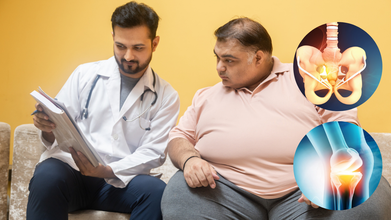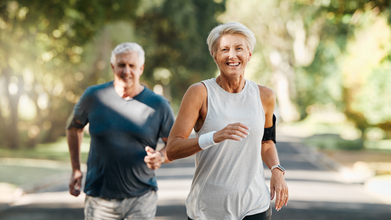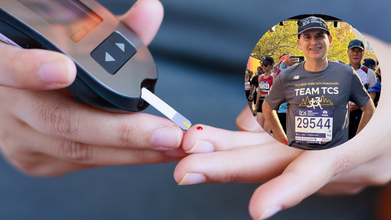- Health Conditions A-Z
- Health & Wellness
- Nutrition
- Fitness
- Health News
- Ayurveda
- Videos
- Medicine A-Z
- Parenting
David Beckham’s Workout At 50 - What Fitness Looks Like For Former Football Legend

(Credit-Davidbeckham/Instagram)
Playing soccer for years meant, being lean and having good muscle endurance and strength. But as he is about to hit 50, David Beckham’s fitness looks a lot more different than it used to. His trainer, Bobby Rich, spoke to a leading men’s health magazine about the new shift in his workout routine, he explained that now his workout was leaning more towards fine tuning major moves and keeping consistent.
Beckham knows that a strong core is more than just having a six-pack. What he is looking for is an improvement in his lifestyle because a lifetime of professional soccer has left him with some back issues. Lower back or back pain can be tackled with good core strength.
So, he works hard on his core muscles to help with that pain. He doesn't just want to look good, he wants to feel good and move well. He does exercises that strengthen his core muscles, not just the ones you can see. Core muscle exercises like these are important as these muscles help him keep his balance and move better in everyday life. By focusing on these important muscles, he keeps his body strong and healthy. He understands that a strong core helps his whole body work better.
Building Strength and Muscle
When Beckham played soccer, he mostly worked on his legs. Now, he focuses on making his whole body strong. He does exercises like push-ups and pull-ups to build muscles in his upper body. He also lifts weights, doing things like deadlifts, squats, and bench presses. His trainer makes sure he doesn't get bored so he changes the exercises a little each time. He might use different weights or do the exercises in different ways. Beckham has built more muscle now than he ever had when he was playing soccer. He exclaims that he even has chest muscles now, he works hard to stay strong and fit as he gets.
Cardio and Active Lifestyle
Beckham likes to do different kinds of cardio exercises. He enjoys things like indoor cycling and boxing. But his favorite exercise right now is playing padel. It's a mix of tennis and squash, and he plays it a few times a week. It's a great way to get his heart pumping and test his agility. He also likes that he can play with his family and friends. Beckham enjoys trying new fitness challenges to keep things interesting. He likes to stay active and fit, and he finds fun ways to get his cardio in. He knows that staying active is important for his health.
Recovery and Maintenance
After working out, Beckham makes sure he helps his body recover. He drinks a protein shake with things like creatine, coconut water, bananas, and almonds. This helps his muscles repair and get stronger. He also uses things like acupuncture and cupping to help with any aches and pains. He learned these techniques when he was a soccer player. He likes to use ice baths and saunas to help his body feel better. He prefers ice baths over cryotherapy. He does contrast therapy, going from the sauna to the ice bath, to help his blood flow and reduce any swelling. He takes care of his body so he can stay healthy and fit.
Obesity Is Driving A Rise In Knee And Hip Surgeries, According To Doctor

Credits: iStock
Obesity is not just about how waist size or BMI, but it’s now reshaping the kinds of injuries patients are coming to orthopedic clinics. According to Dr. Rakesh Mattoo, Director of Orthopedics & Joint Replacement at Max Smart Super Speciality Hospital, Saket, the link between weight gain and joint degeneration is now impossible to ignore. “In India, cases of obesity-related osteoarthritis have increased by 30–35 percent over the last ten years, especially in urban areas,” he explains.
Orthopedic surgeons are seeing the consequences every day. “Approximately 55–60% of our knee replacement patients are now overweight or obese, up from about 35–40% a decade ago,” Dr. Mattoo shares. A similar pattern exists with hip replacements: obesity now accounts for nearly 28–30% of those cases, compared with 15% in 2010. The physics behind this trend are sobering, studies show that “every 5 kg of extra weight increases the load on the knees by approximately 15–20 kg,” accelerating cartilage wear and hastening surgical intervention.
What Is Happening In India?
These clinical numbers reflect a far larger population trend. India’s burden of obesity has been rising steadily for decades. In 2022, around 70 million adults in India were classified as obese, including 44 million women and 26 million men, according to data published in The Lancet. This marks a sharp rise from the early 1990s, when obesity rates were much lower. Overall, obesity prevalence climbed from 1.2% to 9.8% in women and 0.5% to 5.4% in men between 1990 and 2022. Additionally, overweight and obesity together affect nearly one in four Indian adults, nearly 24% of women and 23% of men aged 15–49, and even children are showing increases in overweight prevalence.
It’s not just body weight that matters, but where fat is stored. Central abdominal fat, that stubborn belly, is one of the greatest predictors of early joint degeneration, says Dr. Mattoo. And certain groups are at especially high risk: women (particularly post-menopausal), people with prior knee injuries, those with family histories of osteoarthritis, and individuals leading sedentary lives. Conditions like diabetes, hypothyroidism, and metabolic syndrome also create a kind of chronic internal inflammation that accelerates cartilage breakdown.
How Can You Stay Safe?
So what can someone do to protect their joints before they reach the operating table? Dr. Mattoo emphasizes realistic, sustainable steps:
Keep weight in check: Even losing 5–10% of body weight can significantly ease stress on knees and slow osteoarthritis progression.
Build strength: Strengthening the muscles around the thigh, hip, and knee, along with the core, helps distribute load and protect joints. Moderate, low-impact activities like walking, cycling, or swimming are far kinder to joints than high-impact exercise.
Eat smart: “Choose joint-friendly nutrition,” he urges, including foods rich in omega-3s, calcium, vitamin D, and protein, all essential for healthy muscle and cartilage.
Don’t rush into high-impact activity: Running, jumping, or poorly executed gym movements may feel energizing but can do more harm than good if your body isn’t prepared.
Get routine screening: Annual check-ups — including BMI, vitamin D levels, blood glucose, and lipid profiles — catch early risk factors so that preventive measures can be taken.
Looking at younger adults, building strong musculature between ages 20–35 isn’t vanity — it’s protection. Dr. Mattoo points out that muscle mass helps slow degenerative joint changes over decades. Simple habits like walking 6,000–10,000 steps a day, practicing correct posture, and avoiding harmful sitting patterns or lifting techniques go a long way.
With air pollution keeping many indoors, lifestyle changes have to adapt. Structured home workouts like resistance bands, yoga, or bodyweight exercises can mimic outdoor benefits. Even small changes — standing desks, walk-and-talk phone calls, frequent stretch breaks — increase daily calorie burn and reduce sedentary strain.
The rising tide of obesity isn’t just a statistic; it’s now manifesting in the everyday pain and movement limitations of millions of Indians. But as Dr. Mattoo reminds us, “It’s never too early or too late to make changes that protect your joints and your future mobility.”
Crossed 40? These 5 Habits Could Slow Down Your Aging, According To Doctor

Credits: iStock
Aging brings a shift in how the body functions. Metabolism slows down, hormones fluctuate, and the risk of conditions such as diabetes, heart disease, joint problems, and bone loss begins to rise. Health experts often describe the 40s as a turning point, a decade where prevention matters more than ever. According to US-based longevity doctor Dr Vassily Eliopoulos, many habits that feel harmless in one’s 20s and 30s begin to show their impact sharply after the age of 40.
In a recent Instagram post, Dr Eliopoulos highlighted five things people should stop doing immediately if they want to protect their long-term health. He wrote that this is the decade to take muscle health seriously, make sleep a priority, and let go of small daily habits that quietly speed up aging. He added that the choices made in the 40s decide how well the body functions in the 50s, 60s, and 70s because preventing damage is always easier than trying to repair it later.
Stop cutting back on sleep
Sleep becomes crucial in the 40s because the body needs more time to repair itself. Dr Eliopoulos explains that adults between 40 and 60 require seven to nine hours of sleep every night to maintain hormone balance, protect cognitive function, and support metabolism. Even losing a single hour can make a difference. Research shows the risk of type 2 diabetes, heart disease, and faster brain aging rises for every hour of sleep below the seven-hour mark. Chronic lack of sleep also encourages fat storage around the abdomen, weakens the immune system, and slows recovery after daily activities.
Simple habits such as keeping the room dark and cool, avoiding late-night screen time, and sticking to a regular sleep schedule can make sleep more restorative. Dr Eliopoulos describes good sleep as a free nightly hormone reset.
Stop neglecting strength training
Muscle loss is one of the most predictable changes after 40. According to Dr Eliopoulos, adults lose three to eight percent of their muscle mass each decade unless they actively work against it. Resistance training two to four times a week can slow this decline dramatically.
Strength work helps maintain bone density, improves insulin sensitivity, and builds lean muscle. Exercises such as squats, push-ups, weightlifting, or using resistance bands increase stability, balance, and overall metabolic rate. Studies also show that middle-aged adults build strength more efficiently with resistance training than relying on cardio alone.
Stop relying on highly processed foods
Packaged snacks, sugary drinks, instant meals, and ultra-processed foods can have a much bigger impact in midlife. More than half of adults over 40 struggle with obesity linked to these foods. They cause sudden spikes in blood sugar and promote inflammation, raising the risk of heart failure. These foods also lack fibre, which affects gut health and increases the risk of colon cancer. Brain health is not spared either, with several studies linking diets high in processed food to faster cognitive decline.
Switching to whole foods such as fruit, nuts, vegetables, and yoghurt can help stabilise energy levels and reduce the risk of diabetes. Reading labels to avoid additives and hidden sugars is an important habit at this stage.
Stop delaying routine health tests
Once a person enters their 40s, regular health screenings become essential. Many conditions, including high cholesterol, prediabetes, thyroid disorders, and vitamin deficiencies, develop silently. Monitoring levels such as A1C, lipid profiles, thyroid markers, and vitamin D helps detect issues early, allowing interventions before symptoms show up. Avoiding tests often means missing warning signs until fatigue, pain, or more serious complications appear.
Stop letting stress build up
Stress hits harder in the 40s because the body becomes more sensitive to cortisol. Continuous stress can raise blood pressure, increase inflammation, affect memory, and contribute to anxiety. Long-term stress even accelerates cellular aging and can push biological age forward by several years. When paired with poor sleep or unhealthy eating, stress significantly increases the risk of stroke.
Dr Eliopoulos recommends daily breathing exercises, regular walks, and simple meditation practices to help reduce stress and protect long-term health.
Disclaimer: Please note that this is a user-generated content. Health and Me does not encourage any changes to be made in your daily schedule without consulting your doctor.
Run To Heal: How A 56-year-old NYC Teacher Ran To Reverse His Diabetes

Credits: iStock, PEOPLE
A New York City teacher Pedro Soto, 56, who teachers at the Manhattan school had a simple sore throat and he believed it was from a viral infection, but it soon turned out to be type 2 diabetes.
This was in April 2024, when he went to his doctor with the complaint of a sore throat and took a blood test. This is when he was "officially diagnosed with type 2 diabetes".
In an interview with PEOPLE, he tells while the doctor recommended medications for him, he was determined to make a lifestyle change first. "After receiving the news, I chose not to start medication right away. Instead, I committed to exercising, running twice a week and improving my diet."
Turns out, running, changed his life.
Running With Diabetes: Soto's Determination To Change His Life(style)
Pedro Soto first considered running the TCS NYC Marathon after a colleague mentioned that her husband had completed it. Motivated, he applied through a special program for teachers, sharing an essay about his type 2 diabetes diagnosis. His story earned him a spot on the team. As he trained, he closely monitored his health, undergoing regular blood tests every three months. The improvement surprised him. His blood sugar levels, once concerning, gradually returned to the normal range. While type 2 diabetes cannot be fully cured, it can be reversed, and Soto was seeing that transformation firsthand.
Training Through The Tough Times
The marathon was scheduled for November 2, 2025. Soto’s training, however, didn’t begin smoothly. In June, he learned he had Lyme disease. Around the same time, he lost his father. Because of these back-to-back challenges, he wasn't able to train consistently until August. Running soon became more than exercise. It became a way to navigate grief and rebuild strength.
He describes those months as emotionally heavy. Running offered him space to reflect, heal, and feel close to his father. It became a ritual that allowed him to confront his feelings rather than avoid them.
Experiencing the Race
To prepare mentally, Soto dove into YouTube videos and articles about the marathon. Still, nothing compared to the real thing. To him, race day felt like a citywide block party. The cheering crowds, music, and energy made the pain more bearable. He said that although the long hours of pounding take a toll on joints and muscles, the city's encouragement kept pushing him forward.
Finding Strength in His Students
The toughest stretch came in the final six miles, when self-doubt crept in. What kept him going was thinking about his students. Soto works with teenagers in a transfer program, many of whom have struggled in traditional school systems. Their perseverance inspired him. If his students could show up every day despite their challenges, he believed he could finish the race.
He says he is taking care of his health and this itself is an act of commitment to his students. Whenever he feels healthier, he shows up as a strong educator and for him the marathon teaches him the importance one needs in life of balance, self-care, and knowing when to put themselves first.
© 2024 Bennett, Coleman & Company Limited

